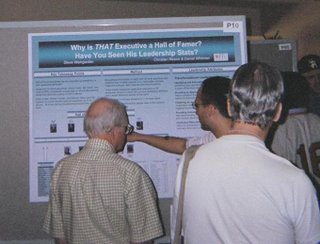
I recently returned from Seattle, where I attended the Society for American Baseball Research (SABR) conference and presented a research poster entitled "Top Major League Baseball Streaks of 2005."
To the right is the city's famous Space Needle, of which I snapped a picture. The Space Needle is part of the larger Seattle Center complex.
Below, I'm standing in front of my poster, clad in a mid-late 1970s, Bill Veeck-inspired Chicago White Sox jersey. Baseball garb is a common form of attire at SABR meetings.

In my poster, I displayed brief synopses of several occurrrences from 2005 that stood out to me, either in terms of estimated statistical rarity or historical significance (i.e., time since previous similar occurrence). Here are the streaks...
Philadelphia’s Jimmy Rollins ended the 2005 season on a 36-game hitting streak, tying him (at the time) for 10th on the all-time list. According to the July 14-19, 2005 USA Today Sports Weekly (providing statistics through roughly the first half of the season), Rollins was batting .273, which converts to a baseline probability of roughly .710 of his getting at least one hit in a game (because a player usually gets multiple at bats in a game, the probability of his getting at least one hit is generally pretty high). This latter probability is raised to the 36th power (length of the streak), yielding as the probability of the streak, .710^36 = .000004.
In August 2005, the Florida Marlins went 25 straight games with no one other than Miguel Cabrera or Carlos Delgado homering (game-by-game log for second half of 2005 season). Using June and July games as a baseline (where at least one Marlin other than the “big two” had homered in 19 of 53 games, .358, or a failure rate of .642), the probability of the drought was .642^25 = .00002.
Poor performance from the Kansas City Royals is not unexpected. Still, when a team loses 19 straight games (as the Royals did in 2005 from late July well into August), it’s noteworthy (game-by-game log). Before the streak, KC had a 38-63 record, for a winning percentage of .376; conversely, this is a .624 losing percentage, which when raised to the 19th power = .0001. (Steve Levitt also looked at the Royals' losing streak last year.)
Seattle’s Ichiro Suzuki, who in 2004 set the single-season record for most hits, suffered through a 0-for-22 slump (longest of his career) in early August 2005. The mid-season Sports Weekly listed him as batting .311 (a failure rate of .689), so the probability of Ichiro’s going hitless in 22 straight official at-bats is .689^22 = .0003.
From mid-July 2005 on, the Red Sox won 19 of 20 at home (log). Boston’s home winning percentage prior to this stretch was .581. Using a binomial-statistic calculator, the team’s probability of winning 19 (or more) out of 20 was roughly .001. (This calculation probably overstates rarity of this hot stretch, as opponents included Tampa Bay, Minnesota, Kansas City, and Texas, plus Chicago White Sox.)
Finally, the 2005 White Sox recorded many impressive streaks:
They won 16 of their last 17 games (5 regular season, 11-1 in post-season). Based on their .611 winning percentage through the end of August, the probability of their winning 16 (or more) games out of 17 was approximately .005. (Cleveland made a late-season run rivaling that of the 1969 New York Mets, but it wasn’t enough to catch the Sox.)
Chicago pitchers recorded four straight ALCS complete games vs. the Angels, a similar post-season achievement not having occurred since Yankee pitchers threw five straight complete games in the 1956 World Series.
Chicago pitchers again worked their magic, not allowing the Astros a hit in their final 29 World Series at bats with runners on base, unprecedented in World Series play since the 1966 Dodgers (31 at bats).
I also mentioned some streaky developments from thus far in 2006 on my poster. Two of them I've already blogged about here (shown below), the University of South Carolina's five straight homers in NCAA play-off action against Georgia (June 12, 2006 entry) and Vladimir Guerrero's hitting against the Texas Rangers (June 5, 2006 entry).
Two additional 2006 streaks I noted on my SABR poster were the Yankees' streak of 10+ hit games and Boston catcher Jason Varitek's homering every May 20 for five straight years (2001-2005), a run that ended in 2006 (thanks to Indiana University professor Jim Sherman for bringing the latter streak to my attention).
Below are some additional photos I took of the SABR poster session (here's the official list of posters, including summaries).





No comments:
Post a Comment